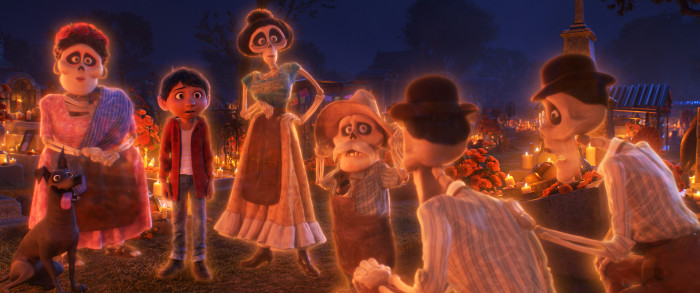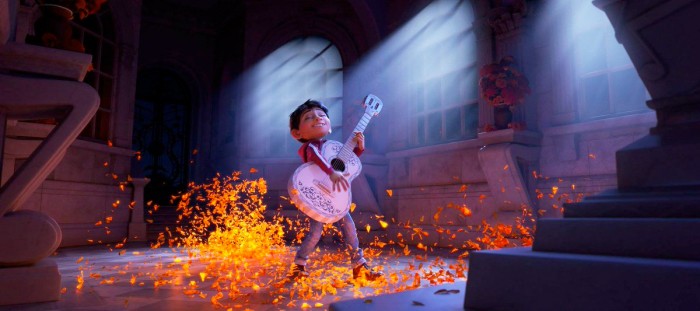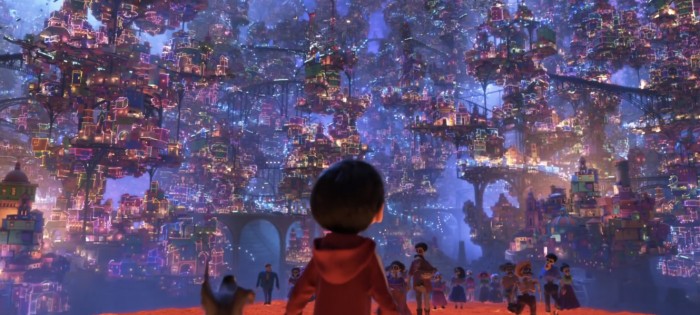How The Family In 'Coco' Reminded Me Of Mine
"This place runs on memories," Hector (Gael Garcia Bernal) informs an awed Miguel (Anthony Gonzalez) as they wander the land of the dead in Pixar's newest film, Coco. Preserved through the memories of their family, people are kept alive, as jubilant in the afterlife as they were in life — sometimes even more so.
In Coco, death is just a new beginning. Less so a film about grief and loss, Coco is a story about celebrating life through the people that the dead once touched and affected. It's aligns perfectly with the values of Dia de los Muertos, otherwise known as the Day of the Dead.
"[In] Dia de los Muertos, the whole point is to never say goodbye to anyone and to always remember them," director Lee Unkrich told me in an interview a few month's prior to the release of Coco. "And it's your responsibility to keep their memories alive."
Tonight is About Family
Despite the Mexican holiday's macabre iconography, the Day of the Dead is a joyous celebration that permeates every corner of that nation's communities: parties are thrown, music is played, the cobbled streets are lit by candlelight and the effervescent glow of scattered marigold petals, and rich flavors waft from the kitchens of every house. It seems like an anomaly to most American audiences, who commonly associate death with somber funeral processions and cold, empty graveyards.
But the rituals of the Day of the Dead are echoed across cultures throughout the world. In China, every house boasts a spirit tablet of ancestors at an altar before which family members light incense and leave food offerings. In Madagascar, millions periodically dance with the bones of the dead and rewrap them in fresh cloth in a ritual called famadihana. In Gaelic Celtic cultures, northwestern Europeans mark the beginning of the harvest by leaving food and drink offerings outside for the spirits who crossed over during this liminal time period; this Celtic pagan ritual would eventually be absorbed into the Catholic All Saint's Day Eve, known today as, you guessed it, Halloween.
"Over the course of working on [Coco], we had done research not only on Mexican customs but also on similar customs and traditions around the world," Unkrich said. "We were surprised by how many different cultures had traditions that are similar to Dia de los Muertos."
These rituals all share one thing in common: they revolve around communicating across the boundary of life and death. Ancestors are but an incense candle or a muttered prayer away from the living, able to convey guidance to the living family members or listen in on the latest town news. It's not based in any one religion — you can find it in Buddhist, Hindu, animist households — but is a surprisingly widespread practice across the world.
Widespread across the world, except perhaps in America. Death is never much cause for celebration in the U.S., much less rituals that celebrate those deaths years later.
"It's interesting that we don't [celebrate these customs] in America, like I wish we did," Unkrich said. I hope that after people see this film they'll start adopting some of these traditions."
But there may be a few more pockets of communities throughout America that celebrate these customs than you would think.
Keeping a Culture Alive
The altar at my home used to be populated by a few grainy photos of austere middle-aged men and women, some clad in magisterial clothes. My grandmother on my father's side smiles serenely from her picture, long, floor-length hair in a tight bun. Now there are a few half-burnt wax candles and an empty incense bowl, but the altar has mostly remained barren for the past few years, with my other relatives' houses becoming the go-to place for the celebration of gio (there's a special character in the proper spelling of this word, but it won't show up here, so if you wish to see how it's really spelled, head here).
Quite literally a "death anniversary," gio is a ceremony in which my extended family members all gather to celebrate the life of a recent deceased relative by eating food — often the favorite dishes of the deceased relative who we're celebrating — and reminiscing. It sounds morbid, I know (I still have trouble explaining to a lot of my friends that I can't hang out with them because I have a "death anniversary"), but it's truthfully one of the most comforting regular rituals of my life. Every few months, I get to see my 25-plus cousins and catch up with the gossip about our lives while eating piping hot cha ca, or debate the merits of the Ken Burns Vietnam War documentary with my uncle. It's almost an afterthought when my mom asks me if I have done lay yet — which is the process of lighting an incense stick and praying to the altar which holds my relative's picture and the dishes of their favorite food.
Not yet, I tell her.
I light the incense stick and watch the end catch fire until it burns down to a sizzle. I'm not religious in the least, but I've always liked this part. Closing my eyes, breathing in the woody smell of incense and clapping my hands together, sometimes I count to 10. Or I ask them how they're doing. "Is heaven nice?" I used to ask my grandmother's picture when I was a kid. I place the incense in a bowl filled with dried rice and the ashy remains of incense sticks before it.
When I watched Coco, it struck me how similar the traditions of the Day of the Dead were to gio. The ofrenda in Coco which became such a pivotal plot point, the food that fills up the altar holding up hundreds of grainy pictures of relatives. The nonchalance with which Miguel treats the whole ritual — it only got in the way of his impassioned pursuit of music.
I was shaken. Here was a culture with which I was so unfamiliar with, and yet it felt like a huge portion of my childhood was playing out on screen. The guilt I felt over brushing off gio so many times as a kid resurfaced, and just seeing the plethora of rich, spicy foods being placed at the ofrenda stirred in me memories of beef stew and rice balls wafting from my aunt's kitchen. I asked Unkrich and Coco co-director Adrian Molina if they had gotten similar responses from people of other cultures like mine.
"I think the fact that so many people do have these traditions and do have these celebrations speaks to the kind of universal desire to have that connection and maintain that connection to the people that you love," Molina said. "And when people see this movie, it's surprising how across cultures everyone has a real emotional reaction because you want that, and you want that for your family."
In With the Old and the New
I used to conflate the tradition of gio with Buddhism, which my father's side identifies with. In Vietnamese culture, the immediate family of the deceased will have a years-long mourning period during which, on the first death anniversary, we would celebrate gio at our local Buddhist temple. This was a much more somber affair — the monks and the strictly vegetarian food probably had something to do with it — but as a kid, I took it as a fact of life. My cousins and I would sometime run around playing tag on the temple grounds, a way to stretch out our cramped legs after an hour of kneeling in the prayer room. When I was younger, my dad used to take us to the Buddhist temple more regularly, but it's been more than 10 months since I last stepped foot in it. The fountain in front of the temple is gone, and I can feel my memories of playing tag on the grounds slowly fading.
Today I associate gio with the "old culture" which I'm already doing a horrible job of preserving. I've lost my knowledge of the Vietnamese language, I can barely name, much less cook, the complex Vietnamese dishes that populate our dinner tables at each gio.
My devoutly Catholic grandmother from my mom's side told me a few years ago, "For gio you cook the favorite meal of whoever's gone and it's like a memory. They can't eat it because they're dead, so it's the living who eat it."
Unlike Miguel in Coco, I've often felt like an outsider looking in on my own culture. I'm the first generation of children born in the U.S. after my family fled Vietnam after the war, but already I can barely speak with my grandmother outside of English. It's been a point of shame for me — Vietnamese was my first language after all.
The clash of new and old generations in Coco resonated so sharply with me because of this. Miguel could not abide by his family's stuffy, traditional ways and set out to achieve his dreams on his own. But in the process, he realized that family and memory may have been the most important thing all along. I asked Unkrich and Molina if there was ever a chance that this tension between new and old generations could have been amplified by making Coco about a Mexican-American — perhaps tapping into a dichotomy I've felt living as an Asian-American all my life.
To my surprise, Unkrich told me that an early idea for Coco revolved around a half-Mexican, half-American kid who journeys down to Mexico to reconnect with a culture he had never known. "I think my initial instinct was that since a lot of our audience wasn't going to be familiar with the Dia de los Muertos was that it made sense to have our character also not be familiar with it," Unkrich said. "So as that character learned about the traditions, the audience would as well."
But the filmmakers scrapped the idea after realizing that the story had become one about loss and "learning to say goodbye to someone you love."
"Whereas Dia de los Muertos," Unkrich continued, "the whole point is to never say goodbye to anyone and to always remember them, and it's your responsibility to keep their memories alive. It was at that point that we kind of ripped the whole story down and...started to tell the story from the inside from a Mexican family."
"That being said, one of the beautiful things about Dia de los Muertos and being Mexican or being Mexican-American is that there's a lot of different experiences," Molina added. "So you totally could tell a story about Dia de los Muertos in a Mexican-American setting and get a whole different set of issues growing up."
I can't express disappointment that there was no story specifically about me as a Vietnamese-American — growing up in a third culture outside of my Vietnamese family and my new American roots — when Coco resonates so well by simply telling a story about family. It's an astonishingly universal story despite being embedded so strongly in Mexican culture. Whether we're grappling with the memories of a culture we want to preserve or over memories of a recently deceased love one, Coco tells that story. And I'll remember that.



